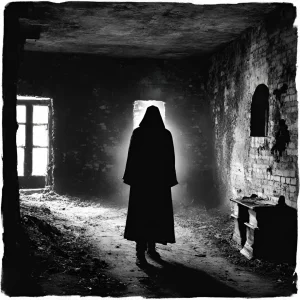Sarah Henry: Patrick Henry’s Basement Kept Wife

Sarah Henry: Patrick Henry’s Basement Kept Wife
History has not been kind to those who suffer from mental health illnesses. It’s easy to disregard or ignore them because their afflictions are invisible. Patrick Henry, known as the “Orator of the Revolution,” had a sick wife and could only do so much for her. Has Sarah Henry’s short and tragic life left her to haunt Scotchtown, her home and prison, to this day?
Patrick Henry
Most know of Patrick Henry for the famous “Give me liberty or give me death!” line announced on the eve of the American Revolution. Most people know little else about the Virginian Statesman. He was so well known for his ability to take the complicated politics, philosophies, and clashing news of the day and par it down for the masses to understand. Henry was so well known for speeches, so it’s not surprising he barely left any written material behind for historians to examine.
He was a staunch opposer of the Constitution when it was becoming ratified. There were lots of amendments that would become the Bill of Rights. He was nervous about the New England states getting too much power over the Southern ones. Still, once done playing Devil’s advocate, he let the vote continue in peace.
Henry was chosen to be the first Governor of Virginia and tried to weld the little power he had to help George Washington fight to British in the Revolutionary Way. He helped with troop numbers and supplies, keeping the war limping along until the French could send aid.
Thomas Jefferson and Henry hated each other. When Henry requested expanded powers as the Governor to help Washington in the field, Jefferson thought he was making a ploy to become a dictator. Afterward, the Orator lived up to his name, and though he was known for his speeches, Henry barely left any written material of his life behind. Jefferson, on the other hand, as the author of the Declaration of Independence, wrote many pieces on his thoughts of Patrick Henry.
Historians have had a difficult time getting a complete and objective picture of Henry. One thing was obvious, though, was how much he loved his first wife, Sarah Shelton, and how he was willing to buck conventional wisdom for her.
Sarah Shelton Henry
Patrick and Sarah were childhood sweethearts and married at a young age. He was 18 and was 16 when they married in 1754. After having six children, Sarah began to show signs that not all was well. Following the birth of their last child Edward (nicknamed ‘Neddy”), Patrick’s mother wrote a letter to his sister explaining that they felt Sarah had lost her mind.
We would say that Sarah was suffering from postpartum depression, but people did not understand mental illness at the time.
Their private doctor suggested that Henry place his wife in Eastern State Hospital in Williamsburg, the only place equipped to deal with the mentally ill. When he went to visit the asylum, he was so appalled by the conditions and treatments there. The patients were treated like criminals: they were bled, shocked, dunked in water, and generally terrified all the time. And this was considered an advancement for the treatment of the mentally ill at the time.
Swearing that his wife would never set foot there, he instead set Sarah up in the basement of their Scotchtown Plantation with a female servant to keep her company.
The Secret Wife
HIding your spouse in the basement may not seem to scream “ best intentions” for a modern audience, but Henry was pretty progressive about the situation.
Knowing how she would be treated at the state-run lunatic asylum, he kept her in her home. She was in a place she knew and could feel safe. A few years into her house arrest, her condition worsened. She had to be kept in a straight dress (a straight jacket of the time) because she was aggressive and would try to hurt herself and others.
Henry was politically active when his wife’s condition worsened. He had a secret staircase built in the back of the house to visit her when he came home. He tried to keep her illness a secret, but word got out, and other servants and slaves refused to go near the house. There’s very little written about the situation because they were keeping her a secret.
In the spring of 1774, Sarah died in the basement. A month later, Henry was still grieving when he gave his famous speech. He spent more time away and eventually sold it so he could move on from watching his beloved succumb to her illness.
Paranormal Happenings at Scotchtown
Scotchtown Plantation was Henry’s home with his wife until he and his second wife moved out in 1777 to the Governor’s Mansion in Williamsburg. It changed hands a few times until 1958 when Preservation Virginia purchased it to restore and open as a museum. It’s believed that Sarah is haunting the grounds and Plantation house.
Things move around on their own, especially in the basement where she lived. Before Preservation Virginia bought the property, the place had been abandoned and left to deteriorate for years. Neighbors would see the flicking on candlelight in the place’s windows and would even see the candlelights moving from room to room.
A group of both children and adults saw a female ghost in a long dress walking from the basement to a building outside used to house servants. Patrick Henry’s great-great-great-granddaughter felt the place was haunted and refused to stay the night there.
A woman named Mary Adams grew up in the house in the 1930s-1940. She had heard noises and other sounds when she stayed there, including the rattling of chains from the basement. She also saw the female ghost with a group of her friends while in the basement.
In the basement, the paint will not stick to the walls. Multiple professional painting crews have tried to paint the basement, but the paint literally “burns” off the walls. Furniture and decor are known to move around overnight. Strange swarms of wasps and flies attach themselves to one specific window in the attic.
Police have responded to multiple reports of motion detectors going off in the night with no intruders present. One officer reported that a woman claimed to see a transparent female in the window. A candle holder from Henry’s time will move from place to place.
The worst experience for a tour guide and their group was when an ear-piercing shriek came from the basement they were standing above! The whole group ran out of the house in terror.
Mental Illness Then and Now
Though Sarah’s treatment was cruel and indefensible, she was treated better than most with mental illnesses. Since her husband had money, he could keep her at home and out of the genuinely awful asylum. However, the reason for keeping her a secret was because of the beliefs of the time.
At this time, mental illness was thought to be a condition of possession by a demonic force or even the Devil himself. The cruel treatments were to chase away the body’s demons in a kind of religious flagellation (holy pain).
Sarah was kept in the basement secret because Henry’s political career would have taken a suicidal nosedive among his constituents and peers. He could not protect his wife completely, though, because when word got out about her condition, the slaves, servants, and workers would refuse to come near the house. They were worried about her being the Devil in disguise.
Sarah died in February 1775 and was buried in an unmarked grave on the property. This was customary practice for those who were considered sick with such demonic forces or evil spirits. It’s thought that she may lie just thirty feet from the door to the basement, but it’s unknown.
It would make sense for Sarah to be trapped on the property–her life was short and painful due to a condition where there was no remedy. Though her death is tragic, she can still teach us an important lesson: mental illness is a sickness, and those affected are just people who need help.
References:
https://en.wikipedia.org/wiki/Patrick_Henry
https://en.wikipedia.org/wiki/Sarah_Shelton_Henry
https://en.wikipedia.org/wiki/Scotchtown_(plantation)
https://americanhistory.si.edu/blog/patrick-and-sarah-henry-mental-illness-18th-century-america
https://seeksghosts.blogspot.com/2012/05/ghost-of-sarah-henry.html
https://preservationvirginia.org/historic-sites/patrick-henrys-scotchtown/
https://www.onlyinyourstate.com/virginia/scotchtown-ghost-story-va/
